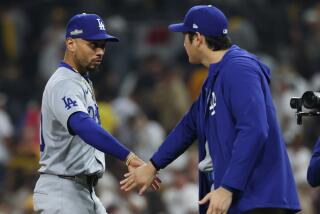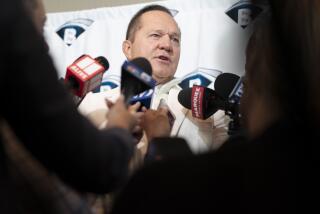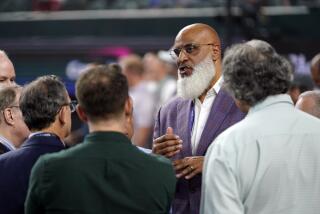PROVIDING THE QUESTIONS AND ANSWERS : What the Talk Means : The Players’ Donald Fehr and the Owners’ Richard Ravitch Have Mastered the Sound Bite--but the Strike Has Deeper Roots
- Share via
NEW YORK — They seem to go from morning to night--from Bryant Gumbel to David Brinkley to Larry King to Ted Koppel.
Crossfire and under fire.
Don Fehr, executive director of the Major League Baseball Players Assn., and Richard Ravitch, chief negotiator for the owners, have received more air time than Whitewater.
It’s the Dick and Don Show or, as others have suggested, Fehr and Loathing.
The Brothers Grimm.
Never have two officials supplied the same answers to the same questions on so many channels.
“Dick has a real bad PR writer,” Fehr said the other day. “He has the same phrases no matter what the question is. I assume his answers are meant for someone.”
Back in line, Geraldo. Wait your turn, Oprah.
Here are still more questions and answers pertaining to the players’ strike, baseball’s eighth work stoppage since 1972:
Question: The owners seem nervous. Are they ready to capitulate?
Answer: Nervous? Merely because Peter Angelos, owner of the Baltimore Orioles, compared their revenue-sharing plan to a welfare state “and you’ve seen what welfare has done to the country?” Merely because Jerry McMorris of the Colorado Rockies blindsided Ravitch by saying the pivotal salary cap issue should be negotiable and endorsed the view of New York Yankee owner George Steinbrenner that the owners should be at the table? So far they are only brush fires, but there definitely is unrest among the bigger market clubs in regard to a prolonged stoppage. Acting commissioner Bud Selig has re-imposed a gag rule in an attempt to quiet it, but history suggests that owner unanimity is an oxymoron.
Q: Why aren’t the owners at the table?
A: For the same reason that the owners have yet to hire a commissioner. Ravitch and Selig, who might be about to relent on this, knew that too many cooks had spoiled too many previous negotiations, so they decided Ravitch and staff would be their lone representatives. Problem is, the owners stripped him of the authority to make significant changes in their proposal, and the players keep fueling the fire by asking what Ravitch is trying to hide by not allowing owners to join him.
Q: Cincinnati Red owner Marge Schott questioned Ravitch’s negotiating experience. Does he have any?
A: Schott has again fallen victim to foot-in-mouth disease. Ravitch has a broad and impressive resume that prompted the owners to hire him for four years at $750,000 per year specifically to redesign the compensation system. Now they are biting at his back. True, he isn’t an experienced baseball negotiator, but he negotiated a New York subway strike as chairman of the Metropolitan Transit Authority, and he is familiar with the give and take of politics. He received a modest 5% of the vote running for mayor of New York in a Democratic primary, but how many owners would receive 5% running in the city where their team plays?
Q: What is at stake financially?
A: The owners have $140 million in TV revenue at stake during the postseason and some of their biggest attendance dates in September. The Angels estimate they will lose $6 million if the rest of the season is canceled. The Chicago White Sox say they will lose $10 million. The owners do not have strike insurance as they did during the 50-day strike of 1981, primarily because some of the biggest carriers, such as Lloyds of London, determined that the insurance motivated the insured to keep the strike going. The owners do have a $260-million line of credit that was opened in 1992 and against which some clubs have already borrowed heavily. The players estimate they will lose $5 million per day in salaries. The union, over the last four years, has retained a portion of each player’s licensing check--about $70,000 a year--in amassing a strike fund of more than $175 million. The first checks, if the strike is still going, will be mailed Sept. 15, a normal pay day for the players, who are paid on the 15th and 30th of each month. They will be paid by their clubs on Monday for the first 11 days of August, and any performance bonus that has been achieved will be paid by the clubs on a prorated basis.
Q: Do managers and coaches get paid?
A: Although they are union members in that they are covered by the union’s pension and benefit plans, managers and coaches will continue to be paid because they are under league contracts. Injured players who are undergoing treatment now or who need follow-up medical treatment or rehabilitation will continue to receive it through their clubs, but the clubs will not otherwise provide facilities or equipment to striking players. The union picked up travel expenses for players returning from the road when the strike began--some clubs allowed players to travel on already booked charters--but the union has asked players not to work out collectively during the strike because of insurance considerations. Fehr, who received $1 million in salary last year, and his administrative staff will not be paid during the strike, but the union’s clerical help will be.
Q: When would the strike have to end for the postseason to be saved?
A: Both sides have dates in mind but aren’t saying what they are. The regular season ends Oct. 2. The general feeling is that play would have to resume by Sept. 20, meaning the strike would have to end several days before that, giving the players time to recondition with their teams. The 50-day strike of 1981 began June 12 and ended July 31. The All-Star game was played Aug. 9. The second half began Aug. 10.
Q: How is this strike different from 1981?
A: The salary cap issue is more ideological and complex than ‘81, when the issue was compensation for the signing of free
agents. There is less middle ground this time, fewer areas of compromise, stronger feelings among all but the biggest clubs that the industry’s overall economic and compensation system have to be changed. At the same time, owners might be under more pressure to find a quick resolution. They do not have strike insurance--the ’81 strike ended about the same time their insurance did--and they lack breathing room if introduction of their new playoff and TV formats are to be saved. Mediation didn’t help in ’81 and is unlikely to help now.
Q: Why is the union so opposed to the salary cap and the owners’ proposal?
A: Four basic reasons: The union believes it would create an artificial ceiling and transfer millions of dollars from players to owners, who currently spend about 58% of revenue on player compensation and would spend 50% under terms of the proposal, although the percentage is negotiable; it would destroy free agency by taking many clubs near or at the cap out of the market and further restrict movement in many cases by providing a players’ current club with the right of first refusal; it would inhibit rather than help (as Ravitch claims) competitive balance, since many roster decisions would be made on the basis of economics rather than ability (because 23 of the 28 teams have reached the postseason in the last 15 years, the union sees no problem with competitive balance and cites the World Series victories of the small-market Minnesota Twins in 1987 and ‘91, along with the success this year of the small-market Montreal Expos); clubs would be less inclined to aggressively market and generate revenue because they would be guaranteed a profit under the cap.
Q: How many clubs are actually losing money?
A: The owners initially said 19 to 21 were projected to lose money this year. They included two cash cows, the Dodgers and Chicago White Sox, on that list. They now say 12 to 14 will lose money, a reduction the union cynically claims is the only progress made in these negotiations. No one knows how many clubs are losing money--some believe only four or five, if that--because the owners won’t open their books. They have provided the union with figures, but the union remains skeptical. For the union, the real bottom line is this: An industry with revenue of $1.9 billion, up from $200 million in 1977, can’t be in distress, as Selig claims, and shouldn’t have to ask the players to pay back the bigger markets for helping out the smaller by linking a salary cap to increased revenue sharing. Also, if it’s such a troubled business, why is the respected Larry Lucchino, former president of the Orioles, heading a group trying to buy the allegedly destitute Pittsburgh Pirates while only the strike is holding up sale of the Tom Werner-wrecked San Diego Padres?
Q: Might not the owners have a case?
A: Sure. Salaries are up 800% since 1976. The major league average is $1.2 million. The union subscribes too deeply, perhaps, to the Marvin Miller edict that you never give negotiating gains back. No one should feel sorry for the players. The owners’ proposal still guarantees them the $1.2 million per year with a chance, according to the owners’ figures, to more than double that over the course of a seven-year contract. The proposal also includes a floor that would actually force some of the small-market clubs to bring their payrolls up to it. There simply is so much doubt about the owners’ contention of a troubled industry. So much doubt about the need for a salary cap when the owners themselves seemed reluctant for so long to help out their allegedly troubled smaller clubs with increased revenue sharing and only did so by linking it to the salary cap that Fehr calls a “Rube Goldberg contraption.” It’s the owners’ house, of course, but is it raining hard enough to require a ceiling, artificial or otherwise? The doubt lingers.
Q: Is there any area of compromise?
A: Only if the owners withdraw the salary cap, and even then it’s murky. Presumably, the owners would ask the players to give up salary arbitration in exchange for unrestricted free agency after three or four years of major league service rather than six. Sources say the union would do that if the minimum salary of $109,000 also received a healthy boost, enabling younger players to move up the financial ladder quicker, compensating for the loss of arbitration.
Q: What happens if owners declare an impasse and unilaterally implement their new system?
A: No one is sure. None of the previous stoppages have gone that far, but the union suspects that this is the owners’ goal, despite the financial and public relations toll from the loss of 52 regular-season dates and the postseason. There are 167 players under contract for 1995, but would they choose to play under terms of a new system? Would the 500-plus unsigned players choose to sign? Would minor leaguers fill the empty spots and automatically become union members and possible scabs if they did? Would the union take its players and start a new league?
Average Baseball Salary
Average baseball salary as compiled by the Major League Baseball Players Assn. and the minimum salary. The 1994 figure is based on a survey by the Associated Press. Beginning in 1979, salary deferrals without interest are discounted at 9% per year. For 1987-93, signing bonuses are increased at 9 percent per year:
1994 Average salary: $1,188,679 Minimum salary: $109,000
Baseball Profits
Operating profits (or losses) for the 26 major league baseball teams (28 teams beginning in 1993), as obtained by the Associated Press
‘93*: $50,329,000
* Management projections
More to Read
Go beyond the scoreboard
Get the latest on L.A.'s teams in the daily Sports Report newsletter.
You may occasionally receive promotional content from the Los Angeles Times.










